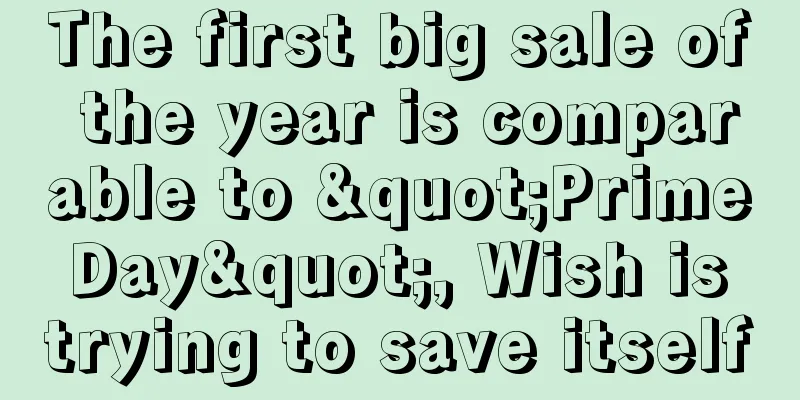Amazon product operation model

|
1. Distribution Model "Distribution of goods", as the name suggests, means uploading products in large quantities through the platform; Amazon distribution refers to Amazon sellers uploading products in large quantities on the Amazon platform. Amazon distribution is one of the common ways for sellers to promote and operate their stores. Especially for novice sellers who have unclear positioning, do not know how to select products, and are eager to place orders, distribution is the first choice for novice sellers to promote their stores. So what methods are usually adopted in the distribution of goods? 1. "Blind distribution": without any planning or goals, just upload whatever resources you have, test the market, and quickly get orders for individual products, so that sales can grow rapidly in the short term. However, this method is only suitable for the imbalance of supply and demand in the platform market, where the number of goods demanded by buyers far exceeds the number of goods provided by sellers, and vice versa. 2. "Popular and hot-selling products": Sellers mainly follow the hot-selling products, and use the platform's hot-selling products as the standard. They upload products that are ranked high and have a large number of orders. This method is less risky than "blind distribution", but it also has certain limitations. It is often only suitable for sellers with a large number of products, a certain competitiveness of the platform, and not enough traffic to test each uploaded product. When uploading products, sellers choose products with potential, market, and selling points, so as to cultivate hot-selling products that meet market demand; otherwise, it will have the opposite effect. 2. Boutique Model The boutique model, or the "small but beautiful" route, requires sellers to focus on a certain niche, have their own core technology, and build each product as a boutique. The so-called boutique means that a store only needs a dozen products to operate in the end. This model is suitable for most products, especially those with a long product life cycle. The boutique model is the exact opposite of the mass-market model. Not mass-marketing means you must carefully select products and conduct refined operations. Amazon is a platform that emphasizes products over stores. To operate an Amazon store, you must learn to simplify and travel light. "Fewer products, better products" is the motto that successful Amazon sellers share with everyone. The key to weakening the store is hot-selling products. Larry, founder of Shenzhen Chuanglan Business Co., Ltd., which focuses on Amazon platform operation services, said that Amazon is a product-oriented platform. Through this platform, if sellers work hard to build their brand and do a good job of marketing, their business will improve. It is not suitable for getting orders by constantly uploading goods, but for doing precision. Mr. Lu, the boss of a foreign trade company in Shenzhen, also said that one of the biggest features that distinguishes Amazon from other foreign trade platforms is that it “emphasizes products and neglects stores.” He sold on the AliExpress platform before joining Amazon. In his opinion, the practice of AliExpress and other foreign trade retail platforms is to distribute goods in large quantities. “At the most, my product listings on AliExpress even reached 2,000. After counting in a month, there are actually only more than 100 products that have orders. Moreover, the orders for these more than 100 products are also relatively evenly distributed, with a few or dozens of each product. It is rare for a small hit product to have a sales volume of 300 pieces per month. The remaining more than 1,000 listings actually have no sales records within 30 days.” He said. In contrast, Mr. Lu found that many excellent Amazon sellers only have dozens of products in their entire stores. What's more terrifying is that some of them only have about 10 products, but the rate of positive reviews every month is as high as hundreds. He explained, "You have to know that the rate of leaving reviews on Amazon is very, very low, which further proves that to do well on the Amazon platform, you must be a 'fine product' and must control the number of single products. Small sellers like us simply don't have the energy to be comprehensive on so many products." Because of the fine products, Mr. Lu's company has also greatly improved the speed and quality of order processing. From the perspective of customer service and after-sales, because there are too many products, sales may not know what some products are, what they are used for, and have very little understanding of the products. However, now sales are very familiar with products, because the whole company only makes 10 to 20 products and contacts them every day. If customers send internal messages to ask about the use or compatibility of products, sales and customer service can give professional answers. Choose hot-selling products and protect registered trademarks. Mr. Lu's company has been able to move lightly by creating hit products. The key to creating hit products lies in product selection. He shared his experience in product selection. "We only selected 10-15 products at the beginning. These products are the best-selling products on Amazon through our investigation. They are all ranked relatively well in the Top Seller list. In addition, the product life cycle cannot be too short (even if the life cycle is too short, it is best to have a substitute or upgraded version of the product). If the product life cycle is too short, the energy and time we have invested in the past may make the product popular, but the product itself may be eliminated by the market, which is also not cost-effective." Mr. Lu said that after a period of time, the sales of his products gradually increased, but Amazon has a "follow-selling" mechanism, that is, if other sellers see that this product is selling well, as long as they have the same product, they can follow the sales on Mr. Lu's product listing and share the traffic of this listing. This caused Mr. Lu some trouble. Larry said that in such a situation, it is best for sellers to register a trademark to protect their products. This is what Mr. Lu did. Larry said that the follow-selling function was set up because Amazon needed to make the platform more concise and customers could find the products they wanted more clearly. New sellers may receive orders quickly, but they may also lose profits due to follow-selling, and soon enter into vicious competition. Sellers must prevent infringement when following sales. Once infringement occurs, they will be warned at the least and their stores will be closed at the worst. One more store can be developed in the same market. Mr. Lu's company has opened two Amazon seller accounts in the United States, and mainly operates one. The monthly sales of this store have exceeded US$80,000, and the gross profit remains at around 30%. "Last August, when my partner and I first got involved in this platform, we also had the idea of 'opening more stores and selling products like crazy'. But the more we did it, the more we felt that it was not necessary. With too many stores and too many products, management would be very chaotic. I would rather have a store with 10 to 20 products, and each product could ship hundreds of units per month, than open many stores and develop hundreds of products, only to end up selling a few dozen units per month for each product. That would not be very interesting and boring. Of course, I also opened a store later as a backup," said Mr. Lu. Larry said that Amazon sellers can also open multiple stores and do business on several sites at the same time. For novices, it will be a bit difficult to adapt to the logistics and languages of different countries at the beginning. Most of the sellers served by Chuanglan Business Service currently use the US site as their main sales platform, and relatively speaking, there are fewer transaction volumes and logistics issues. 3. The difference between mass merchandising and high-quality products The above two methods of Amazon distribution have certain limitations, so some sellers often have this problem. Uploading products through distribution does improve the efficiency of uploading products and increase sales output in a short period of time, but it also brings a series of problems. For example, the store products are messy, the positioning style is confusing, and it is impossible to form a stable customer base; following the hot-selling products often leads to complaints or warnings, and the account often has problems, etc. In fact, these are all caused by not evaluating the market well, positioning the store well, and distributing products reasonably. When the market is not good, high-quality products require a lot of financial and human resources, and there is no return in a short period of time. When it is impossible to fake orders and promotion channels are strictly limited, the difference between high-quality products and mass-produced products of many companies is just the difference between FBA and FBM. Some companies say they are high-quality products, but in fact, their promotion this year is limited to running advertisements and doing promotions. They simply don’t participate in flash sales because they are too expensive, and they don’t do A+ or upload videos. In the eyes of big sellers, this is just mass-produced products like raising pigs. For many cross-border e-commerce companies, they don’t know how to make high-quality products. They can only survive by distributing products. High-quality products are the direction, and high-quality products rely on strength. In summary, general merchandising and premium products are suitable for sellers with different store positioning, and the sellers’ own resources will affect the choice of these two models. General merchandising is not wrong, and premium products are also the choice of more and more sellers. The key is to see how the sellers entering the Amazon market position themselves and make a comprehensive consideration of their own resources to make a choice. They can even combine the two models. |
<<: What are UPC code, EAN code, ASIN code, SKU, and GCID?
>>: Amazon product selection dimensions
Recommend
What is EBANX? EBANX Review
EBANX is a local cross-border payment solution ser...
How should Amazon operations analyze some information?
In the rapidly changing e-commerce landscape, domi...
[Methodology] How to develop corresponding winning operational strategies by monitoring competitor data?
According to Maomao, Amazon sellers before 2017 ra...
BedBath&Beyond files for bankruptcy protection, a home furnishing giant abandoned by the times
It is learned that on April 24, the US home furnis...
Such products are directly removed from the shelves?! Amazon warns sellers via email
Because the blind box format is so popular in Chi...
What are Gift Options? Gift Options Review
Gift Options include Gift Messaging & Gift-Wra...
Halloween spending in the U.S. is expected to reach $11.6 billion in 2024, with early shopping trend rising
It is learned that according to foreign media repo...
What is Vlinkton E-Warehouse? Vlinkton E-Warehouse Review
Vlinkton Cloud Warehouse (Shenzhen Vlinkton Supply...
Retail industry maintains leading position in US digital ad spending! Amazon and Walmart will continue to increase advertising investment
It is learned that according to eMarketer research...
Seize the opportunity of the epidemic! Cross-border sellers turn losses into profits
This epidemic has dampened the confidence of many ...
What is Shoplazza? Shoplazza Review
SHOPLAZZA is a company that focuses on providing p...
In 2021, how to break through the siege and seize the initiative?
I have just finished the main work of the fourth ...
What is Viralix? Viralix Review
Viralix offers a range of services for Amazon sell...
After the big promotion, the storage capacity was cut again? Amazon strongly promotes AWD surrounding services
In the past two days, sellers in our community hav...
The amount involved in the infringement case reached billions, and the seller was innocent this time!
“I don’t have any wisdom, but I can follow others,...









